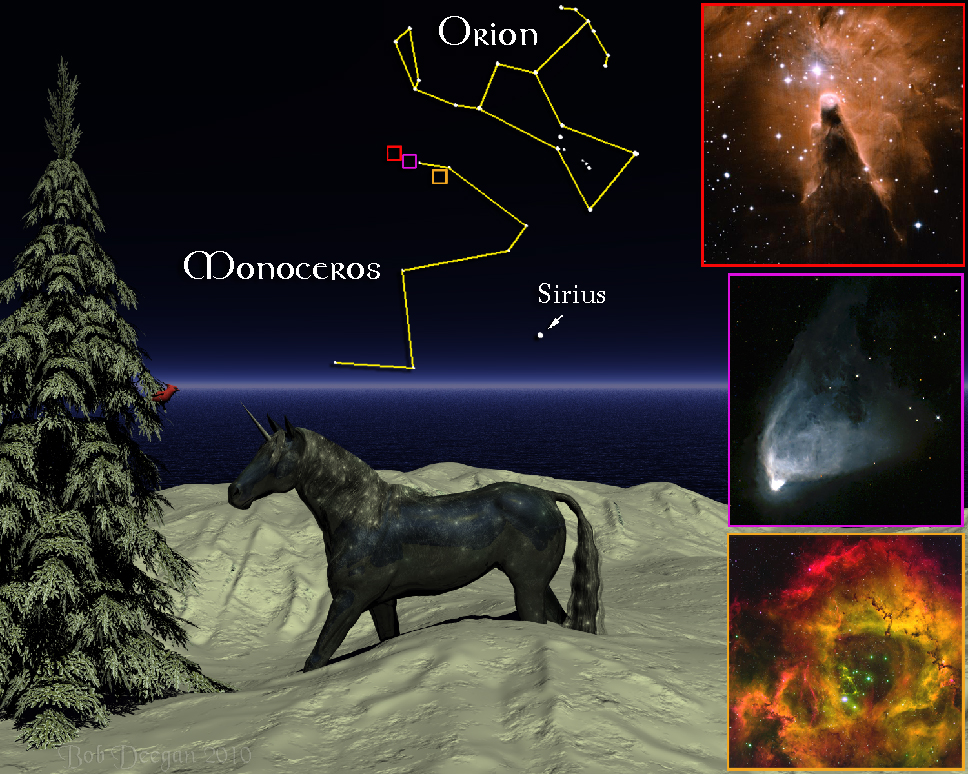
For the week including January 8, 2010

THE UNICORN
The constellation of Monoceros, the Unicorn, covers a fairly large area of sky and contains some marvelous deep sky objects, but the fact that its member stars aren’t very bright makes this Unicorn, like most of them, very difficult to find. The origin of the constellation is equally obscure. One historical source attributes its creation to a Dutch mapmaker named Plancius who supposedly drew it up in the late 1600’s. Other sources credit a fellow named Bartschiuse, but it’s also listed in a book that dates back to the 1500’s. Then too, there’s an ancient celestial sphere from Persia that shows the unicorn as well. It will probably take the discovery of evidence in some dusty manuscript to resolve its background.
As shown in our illustration, Monoceros, the Unicorn, occupies the area of space directly to the left of the constellation of Orion, the Hunter. The bright stars of Orion stand out above the southeastern horizon and will provide an easy guide for amateur stargazers.
Looking among the stars at the top of Monoceros, you will see a patch of light that a pair of binoculars will resolve into a pretty cluster of stars that resembles the number six found on dice. This cluster lies at the center of one of the most arresting sights in our galaxy. On clear, dark nights, using a good telescope, you can see that the cluster is shrouded by haze of smoky light. Shown in the National Optical Astronomy Observatory (NOAO/AURA/NSF) photograph at lower right and matched in our illustration by the rightmost square, this is the Rosette Nebula and the cluster’s stars from its gases and dust. Digital cameras are quickly replacing those using film, but if you have one of those older cameras you can try some easy astrophotography to bring out more of the details of the nebula. To do this, take a 35mm camera and mount it on a tripod. Then, using ASA 400 color film and a 35 or 50mm lens, take a picture of the region of Monoceros. When the picture is developed, you will be amazed at the wealth of colors revealed in the area’s interstellar gases. The secret is to hold the shutter of the camera open for about thirty to forty-five seconds. This gives the film the time it needs to record the faint starlight.
Continuing your telescope tour through Monoceros, you may come across the mysterious object known as Hubble’s Variable Nebula. Shown in the Hubble Space Telescope photograph at center right in our illustration and found in the sky at the location marked by the center square, this is a beautiful, fan-shaped glow of light that looks remarkably like a large comet. It’s called the Variable Nebula because it changes its contours and brightness from week to week. This phenomenon so intrigued astronomers that it was the first object photographed by the great Mount Palomar telescope in 1949. A similar structure is associated with a star in the open cluster NGC 2264. Shown in the NOAO photograph at upper right and found at the spot marked by the leftmost square, the Cone Nebula is a combination of opaque dust clouds and fluorescing hydrogen gas. It takes a strong telescope to find this nebula, but the encompassing cluster of 250 stars is visible in binoculars.Unless otherwise indicated, all content of this web site is the copyright of Robert Deegan and all rights are reserved.
For more information, or to comment, please contact: Bob@NightSkies.org